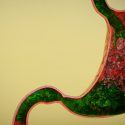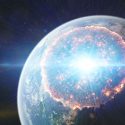With its huge rings of ice and dust, Saturn is one of the Solar System’s most iconic planets. It’s beautiful, really. But what’s it hiding behind those bright clouds? Well, you’re about to find out by taking a stroll on this gas giant’s surface. If you can.
What would it be like to fall through Saturn’s atmosphere? How soon would its extreme conditions bring you to a frozen end? And if, somehow, you did make it to the surface, what would you find?
About 1.2 billion km (746 million mi) away from where you’re standing right now sits Saturn, the sixth planet from the Sun. About nine times wider than Earth, it’s the second-largest planet in the Solar System. Circled by its signature rings of dust, ice and rock, Saturn also has 83 moons orbiting it. 63 of them known, and 20 of them awaiting official confirmation. With an atmosphere mostly made up of hydrogen and helium, this planet is considered a gas giant. This would be important to keep in mind if you plan to take a leisurely stroll along its surface. Because you could just end up falling right through it.
As you approached Saturn, you’d be the first human to take in the glory of its rings and its swirling atmosphere in person. Along the way, you’d pass a few of Saturn’s moons. Like its outermost moon, Iapetus, the icy Enceladus and its biggest moon, Titan. You’d make a note to check that one out on your way back home. But for now, you have a date with Saturn. Soon, you’d be making your way through its massive ring system. This would mean you’re getting close. Saturn’s rings don’t even stretch as wide as the distance between Earth and our own Moon.
You’d fly past each ring in an order that would scramble your understanding of the alphabet. You’d go from the E ring to the G ring and then rings F and A. After that, there’s a gap known as the Cassini Division. Past it, you’d be onto rings B, C and D. Yeah, it might sound like whoever named these rings didn’t know the alphabet too well, but that’s not true. Saturn’s rings were just named in the order they were discovered. You’d pass a lot of stuff inside the rings. Their components range in size from the tiniest grains of ice-dust, to objects like comets, asteroids or pieces of former moons that are as large as mountains back on Earth.
Finally, you’d make it through the D ring, and you’d be hovering just above the planet itself. Nothing left to do but make your final descent. At an altitude of about 1,400 km (870 mi), you’d find yourself surrounded by auras of red and purple. They’d look so different than the ones we have on Earth because of the highly energetic forms of hydrogen in Saturn’s atmosphere. Your fall through would suddenly get more exciting too. You’d begin to get thrown around by powerful gusts of winds. In the upper atmosphere, over the planet’s equator, winds can reach speeds as high as 500 m/s (1,600 ft/s). That’s almost five times stronger than the strongest hurricane-force winds on Earth.
Yeah, so maybe the equator’s not the best place to descend. You’d try coming in for a landing elsewhere. Like Saturn’s north pole. This wouldn’t be ideal either. Because as you descend, a hexagon-shaped storm would be brewing below you. And it would be huge. Spanning about 30,000 km (20,000 mi) across, you could fit about 2.5 Earths inside of it. At least the winds here would be more favorable. But just by a little bit. At the north pole, wind speeds only reach 90 m/s (295 ft/s).
Hopefully, you dressed warm enough for Saturn’s weather because the gas giant’s troposphere has freezing cold clouds of yellow ammonia. The temperature here is about -250 °C (-418 °F). Don’t think that sounds too bad? Well, good for you because that’s 160 °C (288 °F ) colder than the most frigid temperature recorded on Earth. You’d find things starting to warm up as you continued to descend. Next, you’d fall through a layer of light-brown ammonium hydrosulfide clouds, followed by normal clouds made of water. Things would eventually heat up to the more comfortable temperature of 0 °C (32 °F).
But that wouldn’t mean the conditions around you would be comfortable. Temperatures would climb higher and higher. And at these lower levels of the atmosphere, the atmospheric pressure would be as intense as it is in the Mariana Trench, the deepest part of our oceans. At some point, you’d be wondering if you’ll ever reach Saturn’s surface. Well, you’d be disappointed to learn that you kind of already did. It just wasn’t solid. Technically, the surface of this gas giant exists where the atmospheric pressure is equal to that of sea level back on Earth. So it was way back up in the freezing cold atmosphere.
There’s not much that you could look forward to now except continuing to fall straight toward the center of the planet. Of course, the pressure and temperature would be climbing higher and higher. Soon you’d find the pressure so high that all that gaseous hydrogen and helium you’ve been surrounded by would turn into liquid. Hopefully, you brought a heavy-duty umbrella that could handle helium rain. I should’ve warned you about this before you stepped out of the spaceship.
By now, you’d be near the center of Saturn. The planet’s molten rocky core could be about 10 times more massive than Earth’s. Conditions would be beyond intense. Here, it could be as hot as 11,700 °C (21,092 °F) with pressure over 1,000 times what you experience on Earth. Maybe going for a quick stroll on Saturn wasn’t such a smart idea. You’d be thrown into an environment so hostile that it would freeze you, then burn you, then crush you under the planet’s immense pressure. You wouldn’t have a good time. And you didn’t even get a chance to walk on Saturn. Because, well, as you found out, this gas giant doesn’t have a hard surface. What a bummer. The only way you could survive this trip is if you had a special What If-certified spacesuit. The kind that still needs to be invented.
If you somehow did manage to escape from Saturn, you could make a quick stopover somewhere a little more manageable. Like Saturn’s moon, Titan. Approaching this moon, you’d find that it’s larger than our own Moon and even bigger than Mercury. And, Titan’s not just some boring rock, either. Soon you’d be enveloped by its hazy gold and orange atmosphere of nitrogen and methane. The thick haze around you would look a lot like smog back on Earth. But the worst part is, once you get close to the moon’s surface, the atmospheric pressure would make you feel as if you were diving 15 m (50 ft) deep in the ocean. At -180 °C (-290 °F), it would be bone-chillingly cold. The good news is that after all that falling, you’d finally be able to stretch those legs and work on your step count. You’d go for a walk along Titan’s rock-hard water ice.
Strolling along Titan’s surface, you’d encounter all kinds of interesting features. The surface itself would be dark and covered in what would first seem like coffee grounds. These hydrocarbon grains would generate massive dunes, almost like sand dunes back on Earth. There’d be other things that would blow your mind too. You’d discover rivers and lakes. Only instead of water they’d be full of liquid methane and ethane. There’d also be volcanoes spewing liquid water instead of lava.
Sources
- Saturn’s atmosphere. Huygens, C. ESA.
- Saturn’s Temperature: One Cool Planet. Tillman, N (2012). Space.com
- How Does Saturn’s Atmosphere Compare to Earth’s? Kazmeyer, M (2017). Sciencing.
- 10 Need-to-Know Things About Saturn. Nasa (2022). Solar System Exploration.
- Saturn’s Colorful Aurora (annotated). Nasa (2014). Solar System Exploration



























